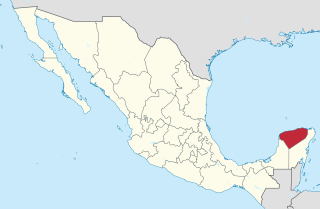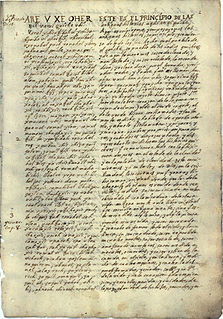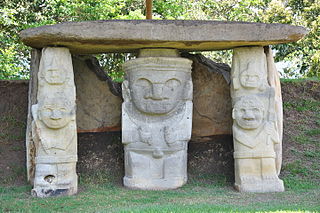Related Research Articles

Yucatán, officially the Free and Sovereign State of Yucatán, is one of the 32 states which comprise the Federal Entities of Mexico. It is divided into 106 municipalities, and its capital city is Mérida.

Popol Vuh is a text recounting the mythology and history of the Kʼicheʼ people, one of the Maya peoples, who inhabit Guatemala and the Mexican states of Chiapas, Campeche, Yucatan and Quintana Roo, as well as areas of Belize and Honduras.
The [Book of the] Songs of Dzitbalché, originally titled The Book of the Dances of the Ancients, is the source of almost all the ancient Mayan lyric poems that have survived, and is closely connected to the Books of Chilam Balam, sacred books of the colonial Yucatec Maya. The sole surviving copy of the Songs of Dzitbalché was written in alphabetic Mayan in the 18th century.

Carlos María de Bustamante Merecilla was a Mexican statesman, historian, journalist and a supporter of Mexican independence. His historical "work early initiated an important Mexican national tradition of searching out and publishing basic materials on the Indian past and its fate in the colonial period." His writings in the 1820s shifted "the antiquarian bias of creole patriotism...into the ideology of a national liberation movement."
Fernando Altamirano was a Mexican physician, botanist and naturalist. He was born in Aculco, studied in Querétaro, and died in Mexico City. Altamirano was the founder and the director of the Instituto Medico Nacional from 1888 to 1908.

Relación breve de la conquista de la Nueva España is the account of friar Francisco de Aguilar, who in his youth took part in the Spanish conquest of the Aztec Empire as a conquistador under the command of Hernán Cortés.

Historia general de las Indias is the account by Francisco López de Gómara of the Spanish conquest of the Aztec Empire. The first printing was in December 1552, in the workshop of Agustín Millán in Zaragoza, published under the title La istoria de las Indias
Miguel Holguín y Figueroa, also written as Miguel Holguín de Figueroa, was a Spanish conquistador. He took part in the expeditions of conquest of the Chitarero, Motilon, U'wa and Lache peoples led by Nikolaus Federmann. Holguín y Figueroa later settled in Tunja, where he protested the rapacious activities of Hernán Pérez de Quesada, governor of Bogotá.
Juan de Sanct Martín, also known as Juan de San Martín, was a Spanish conquistador. Little is known about De Sanct Martín, apart from a passage in El Carnero (1638) by Juan Rodríguez Freyle and Epítome de la conquista del Nuevo Reino de Granada, a work of uncertain authorship. He took part in the expedition from Santa Marta into the Eastern Ranges of the Colombian Andes led by Gonzalo Jiménez de Quesada and founded Cuítiva, Boyacá in 1550. Juan de Sanct Martín headed the left flank of the Spanish troops in the Battle of Tocarema against the Panche on August 20, 1538, while his fellow conquistador Juan de Céspedes commanded the right flank. In this battle, Juan de Sanct Martín killed the cacique of the Panche and was hurt himself. Juan de Sanct Martín had confronted the Panche the year before, when he was sent to the west while De Céspedes went south. Due to the resistance of the bellicose Panche, De Sanct Martín returned to the Spanish camp.

Ortún Velázquez de Velasco was a Spanish conquistador. He is known as the co-founder and first governor of Pamplona in the Norte de Santander department of Colombia, which borders Venezuela.
Pedro Fernández de Valenzuela was a Spanish conquistador who took part in the expedition of the Spanish conquest of the Muisca led by Gonzalo Jiménez de Quesada from 1536 to 1538. He was the cousin of Hernán Venegas Carrillo and after his journey in the New World returned to Córdoba. He was buried in the church of the former Hospital San Bartolomé de las Bubas in Córdoba.
Juan (Francisco) de Céspedes Ruiz was a Spanish conquistador who is known as the founder of the town of Pasca, Cundinamarca, in the south of the Bogotá savanna, Colombia. De Céspedes arrived in the Americas in 1521 and participated in the conquest of the Tairona and the foundation of Santa Marta under Rodrigo de Bastidas. From 1542 to 1543 and in 1546 he served as mayor of Bogotá and after that until 1570 as lieutenant general of the first president of Colombia. Juan de Céspedes married Isabel Romero, one of the first Spanish women who arrived at Colombian territories and had two legitimate sons and one daughter. His date of death is uncertain; in late 1573 or 1576.

Juan Friede Alter was a Ukrainian-Colombian historian of Jewish descent who is recognised as one of the most important writers about Colombian history, the Spanish conquests and a proponent of indigenism; the defense of the rights and descriptions of the oppression of indigenous people.

Juan de(l) Junco was a Spanish conquistador who participated in the Spanish conquest of the Muisca people. Del Junco started his career as a conquistador in the 1526 expedition led by Sebastian Cabot exploring the Río de la Plata in present-day Argentina. In 1535, he arrived in Santa Marta on the Colombian Caribbean coast from where the expedition in search of El Dorado set off in April 1536.
Juan Tafur was a Spanish conquistador who participated in the Spanish conquest of the Muisca people. He was a cousin of fellow conquistadors Martín Yañéz Tafur, Hernán Venegas Carrillo and Pedro Fernández de Valenzuela. Juan Tafur was five times encomendero (mayor) of Santa Fe de Bogotá. He also received the encomiendas of Pasca, Chipaque and Usaquén. The encomienda of Suesca was shared between Tafur and Gonzalo García Zorro.
Martín Yañéz Tafur was a Spanish conquistador who participated in the foundation of Cartagena, the Spanish conquest of the Muisca and the conquest of the Panche.

Pedro Ruíz Corredor was a Spanish conquistador who participated in the Spanish conquest of the Muisca. He searched for El Dorado, returned to Spain, was sent back to the new world, helped consolidate newly conquered Peru for Spain, retired to his fiefdom to raise a family, and lived to a ripe old age.
Antonio Díaz de Cardoso was a Portuguese conquistador who participated in the Spanish conquest of the Muisca people.

Antonio de Lebrija was born in 1507, in Alcántara, Extremadura, Spain; and died in 1540, in Brozas, also in Extremadura. He was a Spanish conquistador who participated in the Spanish conquest of the Muisca and the Chimila peoples. He was the treasurer of the conquest expedition which left Santa Marta in April 1536 following the high quality salt trail, the Camino de la Sal, along the Suárez River up the slopes of the Eastern Ranges of the Colombian Andes towards the Muisca Confederation.
References
- ↑ "Archived copy". Archived from the original on 2017-01-13. Retrieved 2017-01-09.
{{cite web}}: CS1 maint: archived copy as title (link)
- Prem, Hanns J. (1999). "The "Canek Manuscript" and Other Faked Documents". Ancient Mesoamerica. 10 (2): 297–311. doi:10.1017/S0956536199102062. ISSN 0956-5361.
- San Buenaventura, Joseph de (1994). Gabriela Solís Robleda and Pedro Bracamonte y Sosa (ed.). Historias de la Conquista del Mayab, 1511–1679. Mérida: Universidad Autónoma de Yucatán.